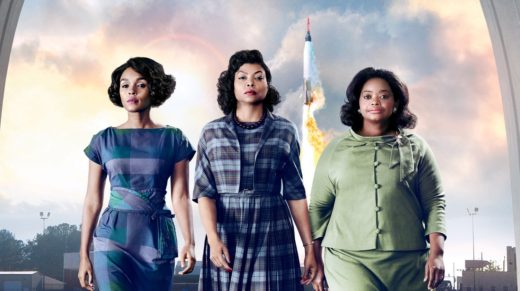
History abounds with examples of unsung science heroes, researchers and visionaries whose tireless efforts led to enormous breakthroughs and advances, often without credit or lasting widespread esteem. This is particularly true for women and minorities, who have historically been under-represented in STEM-related fields. English mathematician Ada Lovelace is broadly considered the first great tech and computing visionary — she pioneered computer programming language and helped construct what is considered the first computing machine (the Babbage Analytical Engine) in the mid-1800s. Physical chemist Dr. Rosalind Franklin performed essential X-ray crystallography work that ultimately revealed the double-helix shape of DNA (Photograph 51 is one of the most important images in the history of science). Her work was shown (without her permission) to rival King’s College biology duo Watson and Crick, who used the indispensable information to elucidate and publish the molecular structure of DNA, for which they would win a Nobel Prize. Dr. Percy Julian, a grandson of slaves and the first African-American chemist ever elected to the National Academy of Sciences, ingeniously pioneered the synthesis of hormones and other medicinal compounds from plants and soybeans. New movie Hidden Figures, based on the exhaustively researched book by Margot Lee Shetterley, tells the story of three such hitherto obscure heroes: Katherine Johnson, Dorothy Vaughn and Mary Jackson, standouts in a cohort of African-American mathematicians that helped NASA launch key missions during the tense 19060s Cold War “space race.” More importantly, Hidden Figures is a significant prototype for purpose-driven popular science communication — a narrative and vehicle for integrated multi-media platforms to encourage STEM diversity and scientific achievement.

The participation of women in astrophysics, space exploration and aeronautics goes back to the 1800s at the Harvard College Observatory, as chronicled by Dava Sobell in The Glass Universe, a companion book to Hidden Figures. These women, every bit as intellectually capable and scientifically curious as their male counterparts, took the only opportunity afforded to them, as human “computers,” literally calculating, measuring and analyzing the classification of our universe. By the 1930s, the National Advisory Committee for Aeronautics, a precursor that would be subsumed by the creation of NASA in 1958, hired five of these female computers for their Langley aeronautical building in Hampton, Virginia. Shortly after World War II, with the expansion of the female workforce and war fueling innovation for better planes, NACA began hiring college-educated African American female computers. They were segregated to the Western side of the Langley campus (referred to as the “West Computers”), and were required to use separate bathroom and dining facilities, all while being paid less to do equal work as their white counterparts. Many of these daily indignities were chronicled in Hidden Figures. By the 1960s, the Space Program at NASA was defined by the two biggest sociopolitical events of the era: the Cold War and the Civil Rights Movement. Embroiled in an anxious race with Soviet astronauts to launch a man in orbit (and eventually, to the Moon), NASA needed to recruit the brightest minds available to invent seemingly impossible math to make the mission possible. Katherine Goble (later Johnson), was one of those minds.
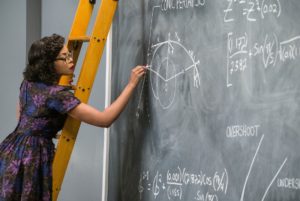
Katherine Johnson (portrayed by Taraji P. Henson) was a math prodigy. A high school freshman by the time she was 10 years old, Johnson’s fascination with numbers led her to a teaching position, and eventually, as a human calculator at the Langley NASA facility. Hand-picked to assist the Space Task Group, portrayed in the movie as Al Harrison (Kevin Costner), a fictionalized amalgamation of three directors Johnson worked with in her time at NASA, she had to traverse institutionalized racism, sexism and antagonistic collaborators in her path. Johnson would go on to calculate trajectories that sent both Alan Shepard and John Glenn into space, as well as key data for the Apollo Moon landing. Supporting Johnson are her good friends and fellow NASA colleagues Dorothy Vaughan (Octavia Spencer) and Mary Jackson (Janelle Monáe). Vaughan herself was a NASA pioneer, becoming the first black computing section leader and IBM FORTRAN programming expert. Jackson became the first black engineer at NASA, getting special permission to take advanced math courses in a segregated school.
Katherine Johnson’s legacy in science, mathematics, and civil rights cannot be understated. Current NASA chief Charles Bolden thoughtfully paid tribute to the iconic role model in Vanity Fair. “She is a human computer, indeed, but one with a quick wit, a quiet ambition, and a confidence in her talents that rose above her era and her surroundings,” he writes. The Langley NASA facility where she broke barriers and pioneered discovery honored Johnson by dedicating the building in her name last May. Late in 2015, Johnson was bestowed with a Presidential Medal of Freedom by President Barack Obama.
Featured prominently in Hidden Figures, technology giant IBM has had a long-standing relationship with NASA ever since the IBM 7090 became the first computing mainframe to be used for flight simulations, with the iconic System/360 mainframe engineering the Apollo Moon landing. Although IBM mainframes are no longer in use for mathematical calculations at NASA, they are partnering through the use of artificial intelligence for space missions. IBM Watson has the capability to sift through thousands of pages of information to get pilots critical data in real time and even monitor and diagnose astronauts’ health as a virtual/intelligence agent.
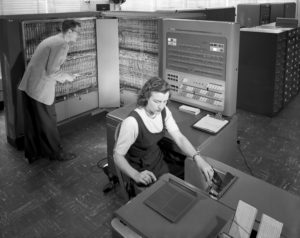
More importantly, IBM is taking a leadership role in developing STEM outreach education programs and a continued commitment to diversifying the technology workforce for the demands of the 21st Century. 50 years after Katherine Johnson’s monumental feats at NASA, the K-12 achievement gap between white and black students has barely budged. Furthermore, a 2015 STEM index analysis shows that even as the number of STEM-related degrees and jobs proliferates, deeply entrenched gaps between men and women, and an even wider gap between whites and minorities, remain in obtaining STEM degrees. This is exacerbated in the STEM work force, where diversity has largely stalled and women and minorities remain deeply under-represented. And yet, technology companies will need to fill 650,000 new STEM jobs (the fastest growing sector) by 2018, with the highest demand overall for so-called “middle-skill” jobs that may only require technical or community college preparation. Launched in 2011 by IBM, in collaboration with the New York Department of Education, P-TECH is an ambitious six-year education model predominantly aimed at minorities that combines college courses, internships and mentoring with a four year high school education. Armed with a combined high school and associates’ degree, these students would be immediately ready to fill high-tech, diverse workforce needs. Indeed, IBM’s original P-TECH school in Brooklyn has eclipsed national graduation rates for community college degrees over a two-year period, with the technology company committing to widely expanding the program in the coming years. Technology companies becoming stakeholders in, and even innovators of, educational models and partnerships can have profound impacts in innovation, economic growth and diminishing poverty through opportunity.
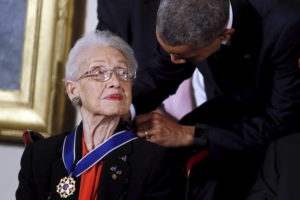
Dovetailing with the release of Hidden Figures, IBM has also partnered with The New York Times to launch their first augmented reality experience. Combining advocacy, outreach and data mining, the free, downloadable app called “Outthink Hidden” combines the inspirational stories portrayed in Hidden Figures with digitally-interactive content to create a PokemonGo-style nationwide hunt about STEM figures, historical leaders, places and areas of research across the country. The app can be used interactively at 150 locations in 10 U.S. cities, STEM Centers (such as NASA Langley Research Center and Kennedy Space Center) and STEM Universities to learn not just about the three mathematicians featured in Hidden Figures, but also other diverse STEM pioneers. Coupled with the powerful wide impact of Hollywood storytelling and a complimentary book release, “Outthink Hidden” could be an important prototype for engaging young tech-savvy students, possibly even in organized, classroom environments, and promoting interest in exploring STEM education, careers and mentorship opportunities.
There are no easy solutions for reforming STEM education or diversifying the talent pool in research labs and technology companies. But we can provide compelling narrative through movies and TV shows, and, increasingly, digital content. Perhaps the first step to inspiring and cultivating the next Katherine Johnson is simply to start by telling more stories like hers.
View a trailer for Hidden Figures:
*****************
ScriptPhD.com covers science and technology in entertainment, media and advertising. Hire our consulting company for creative content development. Follow us on Twitter and Facebook. Subscribe to our podcast on SoundCloud or iTunes.
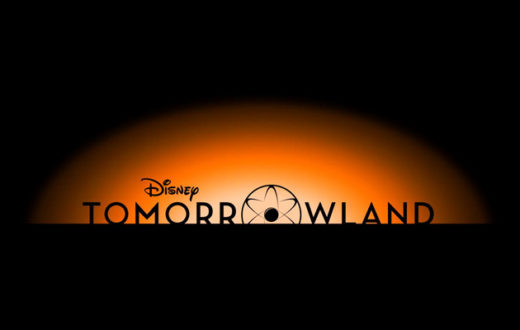
One of Walt Disney’s enduring lifetime legacies was his commitment to innovation, new ideas and imagination. An inventive visionary, Disney often previewed his inventions at the annual New York World’s Fair and contributed many technological and creative breakthroughs that we enjoy to this day. One of Disney’s biggest fascinations was with space exploration and futurism, often reflected thematically in Disney’s canon of material throughout the years. Just prior to his death in 1966, Disney undertook an ambitious plan to build a utopian “Community of Tomorrow,” complete with state-of-the-art technology. Indeed, every major Disney theme park around the world has some permutation of a themed section called “Tomorrowland,” first introduced at Disneyland in 1955, featuring inspiring Jules Verne glimpses into the future. This ambition is beautifully embodied in Disney Picttures’ latest release of the same name, a film that is at once a celebration of ideas, a call to arms for scientific achievement and good old fashioned idealistic dreaming. The critical relevance to our circumstances today and full ScriptPhD review below.
“This is a story about the future.”
With this opening salvo, we immediately jump back in time to the 1964 World’s Fair in New York City, the embodiment of confidence and scientific achievement at a time when the opportunities of the future seemed limitless. Enthusiastic young inventor Frank Walker (Thomas Robinson), an optimistic dreamer, catches the attention of brilliant scientist David Nix (Hugh Laurie) and his young sidekick Athena, a mysterious little girl with a twinkle in her eye. Through sheer curiosity, Frank follows them and transports himself into a parallel universe, a glimmering, utopian marvel of futuristic industry and technology — a civilization gleaming with possibility and inspiration.

“Walt [Disney] was a futurist. He was very interested in space travel and what cities were going to look like and how transportation was going to work,” said Tomorrowland screenwriter Damon Lindelof (Lost, Prometheus). “Walt’s thinking was that the future is not something that happens to us. It’s something we make happen.”
Unfortunately, as we cut back to present time, the hope and dreams of a better tomorrow haven’t quite worked out as planned. Through the eyes of idealistic Casey Newton (Britt Robertson), thrill seeker and aspiring astronaut, we see a frustrating world mired in wars, environmental devastation and selfish catastrophes. But Casey is smart, stubborn and passionate. She believes the world can be restored to a place of hope and inspiration, particularly through science. When she unexpectedly obtains a mysterious pin — which we first glimpsed at the World’s Fair — it gives her a portal to the very world that young Frank traveled to. Protecting Casey as she delves deeper into the mystery is Athena, who it turns out is a very special time-traveling recruiter. She distributes the pins to a collective of the smartest, most creative people, who gather in the Tomorrowland utopia to work and invent free of the impediments of our current society.

Athena connects Casey with a now-aged Frank (George Clooney), who has turned into a cynical, reclusive iconoclastic inventor (bearing striking verisimilitude to Nikola Tesla). Casey and Frank must partner to return to Tomorrowland, where something has gone terribly awry and imperils the existence of Earth. David Nix, a pragmatic bureaucrat and now self-proclaimed Governor of a more dilapidated Tomorrowland, has successfully harnessed subatomic tachyon particles to see a future in which Earth self-destructs. Unless Casey and Frank, aided by Athena and a little bit of Disney magic, intervene, Nix will ensure the self-fulfilling prophesy comes to fruition.
As the co-protagonist of Tomorrowland Casey Newton symbolizes some of the most important tenets and qualities of a successful scientist. She’s insatiably curious, in absolute awe of what she doesn’t know (at one point looking into space and cooing “What if there’s everything out there?”) and buoyant in her indestructible hope that no challenge can’t be overcome with enough hard work and out-of-the-box originality. She loves math, astronomy and space, the hard sciences that represent the critical, diverse STEM jobs of tomorrow, for which there is still a graduate shortage. That she’s a girl at a time when women (and minorities) are still woefully under-represented in mathematics, engineering and physical science careers is an added and laudable bonus. She defiantly rebels against the layoff of her NASA-engineer father and the unspeakable demolition of the Cape Canaveral platform because “there’s nothing to launch.” The NASA program concomitantly faces the tightest operational budget cuts (particularly for Earth science research) and the most exciting discovery possibilities in its history.

The juxtaposition of Nix and Walker, particularly their philosophical conflict, represents the pedantic drudgery of what much of science has become and the exciting, risky brilliance of what it should be. Nix is pedantic and rigid, unable or unwilling to let go of a traditional credo to embrace risk and, with it, reward. Walker is the young, bushy-tailed, innovative scientist that, given enough rejection and impediments, simply abandons their research and never fulfills their potential. This very phenomenon is occurring amidst an unprecedented global research funding crisis — young researchers are being shut out of global science positions, putting innovation itself at risk. Nix’s prognostication of inevitable self-destruction because we ignore all the warning signs before our eyes, resigning ourselves to a bad future because it doesn’t demand any sacrifice from our present is the weary fatalism of a man that’s given up. His assessment isn’t wrong, he’s just not representative of the kind of scientist that’s going to fix it.
“Something has been lost,” Tomorrowland director Brad Bird believes. “Pessimism has become the only acceptable way to view the future, and I disagree with that. I think there’s something self-fulfilling about it. If that’s what everybody collectively believes, then that’s what will come to be. It engenders passivity: If everybody feels like there’s no point, then they don’t do the myriad of things that could bring us a great future.”
Walt Disney once said, “If you can dream it, you can do it.” Tomorrowland‘s emotional call for dreamers from the diverse corners of the globe is the hope that can never be lost as we navigate a changing, tumultuous world, from dismal climate reports to devastating droughts that threaten food and water supply to perilous conflicts at all corners of our globe. Because ultimately, the precious commodity of innovation and a better tomorrow rests with the potential of this group. We go to the movies to dream about what is possible, to be inspired and entertained. Utilizing the lens of cinematic symbolism, this film begs us to engage our imaginations through science, technology and innovation. It is the epitome of everything Walt Disney stood for and made possible. It’s also a timely, germane message that should resonate to a world that still needs saving.
Oh, and the blink-and-you-miss-it quote posted on the entrance to the fictional Tomorrowland? “Imagination is more important than knowledge.” —Albert Einstein.
View the Tomorrowland trailer:
Tomorrowland goes into wide release on May 22, 2015.
*****************
ScriptPhD.com covers science and technology in entertainment, media and advertising. Hire our consulting company for creative content development. Follow us on Twitter and Facebook. Subscribe to our podcast on SoundCloud or iTunes.

“I think we’re living through the greatest age of discovery our civilization has ever known,” declares British physics superstar Professor Brian Cox as a preamble for each episode of The Science Channel’s BBC import Wonders of the Solar System. Episode by episode, Dr. Cox deconstructs our wondrous Universe one focus at a time—the Sun, the Big Bang, life on other planets. But he does something even more important. He infuses his own obvious enthusiasm and passion for his field in each experiment and factoid. As a viewer, you can’t helped but be absorbed in the intergalactic vortex of knowledge. The timing of this mini-series and emergence of Cox’s exuberant personality could not be better. Funding for NASA missions has been cut dramatically, with an ongoing re-evaluation the role space exploration should play in the national budget and science ambition. American viewers should get used to Cox as a modern-day Carl Sagan, because his star is rising fast. ScriptPhD.com was extraordinarily fortunate to sit down with Dr. Cox in Los Angeles for a one-on-one podcast about the show, the current state of space exploration, and what is possible to achieve experimentally if we only try. My conversation with the inspirational, eloquent and brilliant Brian Cox, along with our review of Wonders of the Universe, under the “continue reading” cut.

Astronomy was never my strongest suit academically. And while I’ve always had a respectful admiration for the solar system and interplanetary sciences, I was never the kind to stargaze or spend hours on the telescope on the off-chance of spotting Mars, Venus or the Saturn rings. It’s a testament, then, to the immensity, ambition and quality of The Science Channel’s latest mini-series project, Wonders of the Solar System for holding me positively captivated while screening the first two episodes. A concept as simple as a solar eclipse is the running theme for the entirety of the first episode, “Empire of the Sun.” By the time the eclipse is recorded, it is the climax to an astounding collection of facts about how rare, precious and ordered the Sun (and its position to the Earth really is). A perfect eclipse is only possible right here on planet Earth—400 times the planetary distance away from the Moon, with the Sun an exact 400 times the diameter of the Moon. No other moon in the vast expanse of the solar system has these properties. Pretty amazing stuff, right? The timing of Wonders of the Solar System could not come at a better time. With our economic and moral spirits at a nadir, it’s time to discuss the importance of space travel and exploration to our scientific, nationalistic and optimistic psyches. President Obama’s 2011 NASA budget, while providing an increase of $6 billion for technology innovation, scrapped manned space flights, including a manned mission to the Moon and any proposals of future Mars exploration. Neil Armstrong, the first man to walk on the Moon, strongly criticized the move as handicapping spaceflight and exploratory ambition. One of the things Wonders of the Universe reminds us, and that Dr. Cox reiterated in our podcast below, is that scientific discoveries come out of limitless ambition, and often from asking completely unrelated questions. Nothing is more ambitious for mankind than exploring the Universe that houses our miraculous existence. Future episodes will examine the Wonders of our atmosphere, the similarity between our planet and Mars, and most excitingly, examining the possibilities of alien life in the solar system.

Part of the appeal of Wonders is that unlike many educational platforms that talk at the viewer in order to inform, Wonders feels like an interactive, experimental experience. When Cox isn’t zipping from one far-fetched corner of the world to another (catching an aurora borealis in the Arctic Circle! a solar eclipse in India! Mars-watching in Tunisia!), he’s pointing out cool, and often eye-catching, experiments that show viewers the science and physics that makes our solar system so fantastically unique. Who would ever know that a tornado in the Midwest is actually a physics parallel to the formation of our very universe. The scientific principle at hand—conservation of angular momentum—stopped the solar system from collapsing under its own gravity during formation, allowing a stable, rotating disc of planets to form. We all know the sun is powerful, shining 1 kW of energy for meter squared of the Earth’s surface, equal to one million times the yearly power consumption of the United States in each second! But it’s a lot more fun to watch Cox show this measurement in Death Valley with a pail of water, a thermometer, and some physics. Likewise the Sun’s sunspots, a still not quite understood phenomenon that has been correlated to the Earth’s seasons and weather, which Cox illustrates with a digital camera. All of this extemporaneous experimentation is reminiscent of the best of Carl Sagan, just with a modern twist.
The Los Angeles Times, in their television review of Wonders called Brian Cox “the nerd that’s cooler than you.” Already a budding superstar in the world of particle physics (check out his TED talk on his work at CERN’s Hadron Supercollider), Cox is that perfect mix of half-scientist, half-TV star. Without him, Wonders would be a completely different endeavor. (Listen to our podcast below as an example of his charismatic eloquence.) To boot, BBC and The Science Channel spared no expenses when it came to production values. In our one on one meeting, Cox let us in on the secret that the whole of Wonders was filmed with an old-fashioned 1970s cinematic lens, lending a decidedly movie feel to the show, particularly the graphics and digital sequences. While some imagery is real, such as amazing Martian sunsets captured by the Mars rover, other digital effects (notably in the “Empire of the Sun” episode) are stunning enough to make you feel like your television is the portal window of a spacecraft in intergalactic orbit.
Wonders of the Solar System airs on The Science Channel on Thursdays at 9 PM ET.
While in Los Angeles to promote Wonders of the Solar System, Dr. Cox graciously sat down with ScriptPhD.com to discuss the show and his views on space exploration. Among our discussion topics:
•How he is still able to channel a passion for the solar system
•Why he thinks it’s critical for NASA to take risks and go to Mars
•The possibilities of life in the outer solar system and
•Why it’s a huge mistake for NASA to cut their budget for space exploration
Take a listen below:
~*ScriptPhD*~
*****************
ScriptPhD.com covers science and technology in entertainment, media and advertising. Hire our consulting company for creative content development.
Subscribe to free email notifications of new posts on our home page.
]]>